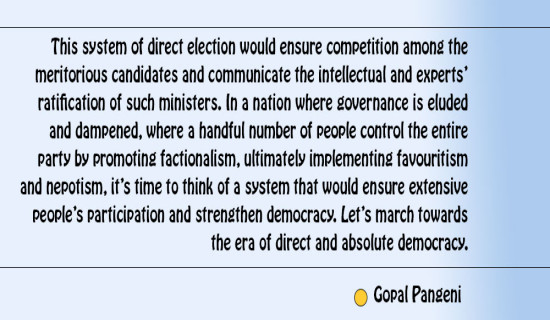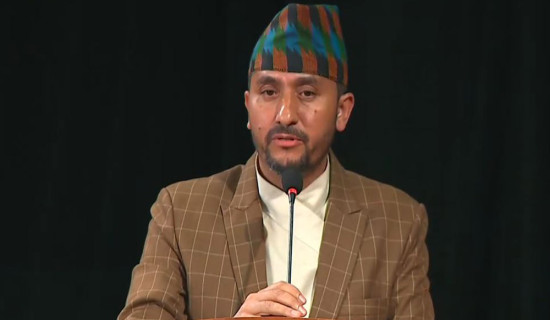- Wednesday, 22 October 2025
Modern Technology For Power Development
Nepal has enormous potential for renewable energy development and has made reasonable progress in providing clean, renewable, accessible, affordable, and reliable energy to citizens. Until couple of years in the past, the country faced 14-16 hours of power cuts daily. However, the nation has now become a power surplus (at least during monsoon) and has even begun exporting electricity to India. Recognising that the supply of affordable, clean, renewable, and reliable electricity is critical for sustainable development, the government has made substantial investments in developing renewable energy, partnering with the private sector. But there are many challenges in fulfilling the Sustainable Development Goal (SDG) - "ensure access to affordable, reliable, sustainable, and modern energy for all."
The most critical challenge is that power projects are often not completed on time, thereby adding to the initial costs. These time overruns could be due to several underlying causes, such as lack of integrated resource planning (IRP), limitations in the capital, and lack of technical capacities for appropriate infrastructure design and modelling suitable to the terrain. Another challenge is that Nepal has many hydroelectricity generation projects expected to come into commercial operation soon but lacks enough transmission lines with adequate capacity to transfer the generated electricity from the distribution centres. This adds to the existing limitations in distribution of infrastructure capacities to supply quality electricity to consumers. With a target of transferring 15,000 MW of generated electricity, the government plans to build more than 200 transmission lines.
Online monitoring
The rise of AI (Artificial Intelligence) techniques has dramatically helped improve power system planning and management globally, but Nepal has yet to adopt such a technology and reap benefits from this. Currently, more than 10,000 circuit kilometres of lines under operation are owned by Nepal Electricity Authority (NEA), but there is no automatic preventive maintenance. Online monitoring systems powered by AI could help obtain a complete real-time picture of the system to identify and fix problems quickly. Further, the manually operated Integrated Nepal Power System (INPS) could be replaced by AI-based systems synchronous with the Indian Grid to ensure the system's dependability, security, and robustness. The improved INPS is also needed as we target to become an electricity exporting country with self-sufficiency in year-round energy by 2030, integrating into the regional electricity market and engaging trade with neighbouring countries.
The government has prepared plans for the restructuring of the energy sector. It is moving towards more automation but has been facing challenges in executing such plans and becoming future-oriented due to limitations in technical expertise. Through the experiences of public hearings and dispute settlements of licensing, designing, monitoring, evaluating, and construction of hydropower and transmission line projects by Ministry of Energy, Water Resources, and Irrigation (MOEWRI), we become aware of the concerns of people who are affected by these projects. They are interested in seeing progress, but they also want to know how long they will have to sacrifice their habitats for the greater good of the nation. That is why land acquisition is one of the major challenges for infrastructure development in Nepal.
Most of the of independent power producers (IPPs) and public or privately owned power producers are facing several issues during their project development. Without a clear plan for execution, many people could lose their homes and land. To address this issue, the government has initiated a master plan for generation, distribution and transmission line projects. Because Nepal is a small nation, it is necessary to concurrently carry out development initiatives and settle our inhabitants in a very small area. Thus, appropriate integrated resource planning can aid in clearing the impacted areas and reducing the amount of land needed to be acquired for the project in order to properly integrate it with ongoing initiatives.
The Ministry last fiscal year prepared a comprehensive action plan for the Alternative Energy Promotion Centre (AEPC) and NEA — both under the Ministry of Energy, Water Resources, and Irrigation — outlining the current electrification status of the country and a detailed plan for more than 300,000 households for future electrification. More such works and initiatives are needed to provide clear-cut vision to the implementing agencies.
Current needs
Engineering is not limited to power transmission and distribution feeding it to the consumers’ house. But how consumers are using it is also a big challenge, and according to their demands, we should shape our system. For this reason, time-to-time enhancement is inevitable. Currently, the Nepal government is encouraging the usage of electricity with the target of replacing it by 40 per cent. This goal is not unachievable but we need technically sound, implementable quick and long-term plans. So that it can best fit our nation's current needs. Hence, this sector needs technical experts who have delved deeper knowledge of resilient and integrated infrastructure design and planning.
There is a growing necessity to consider AI in design is repeatedly highlighted to practicing engineers in Nepal. We are in the phase of learning by doing, and a lot more issues are in line with the implementation phase of projects, such as gender issues, power trading and climate resilience. While making any policy guideline, budgeting and constructing the projects, the gender equality perspective has also emerged in the country. Therefore, the practical implementation of power system engineering with the lens of gender equality, climate resilience, power trading and most importantly AI based power system design and modelling is inevitable now.
(Jha is a senior divisional engineer (electrical) at the Ministry of Energy.)

















